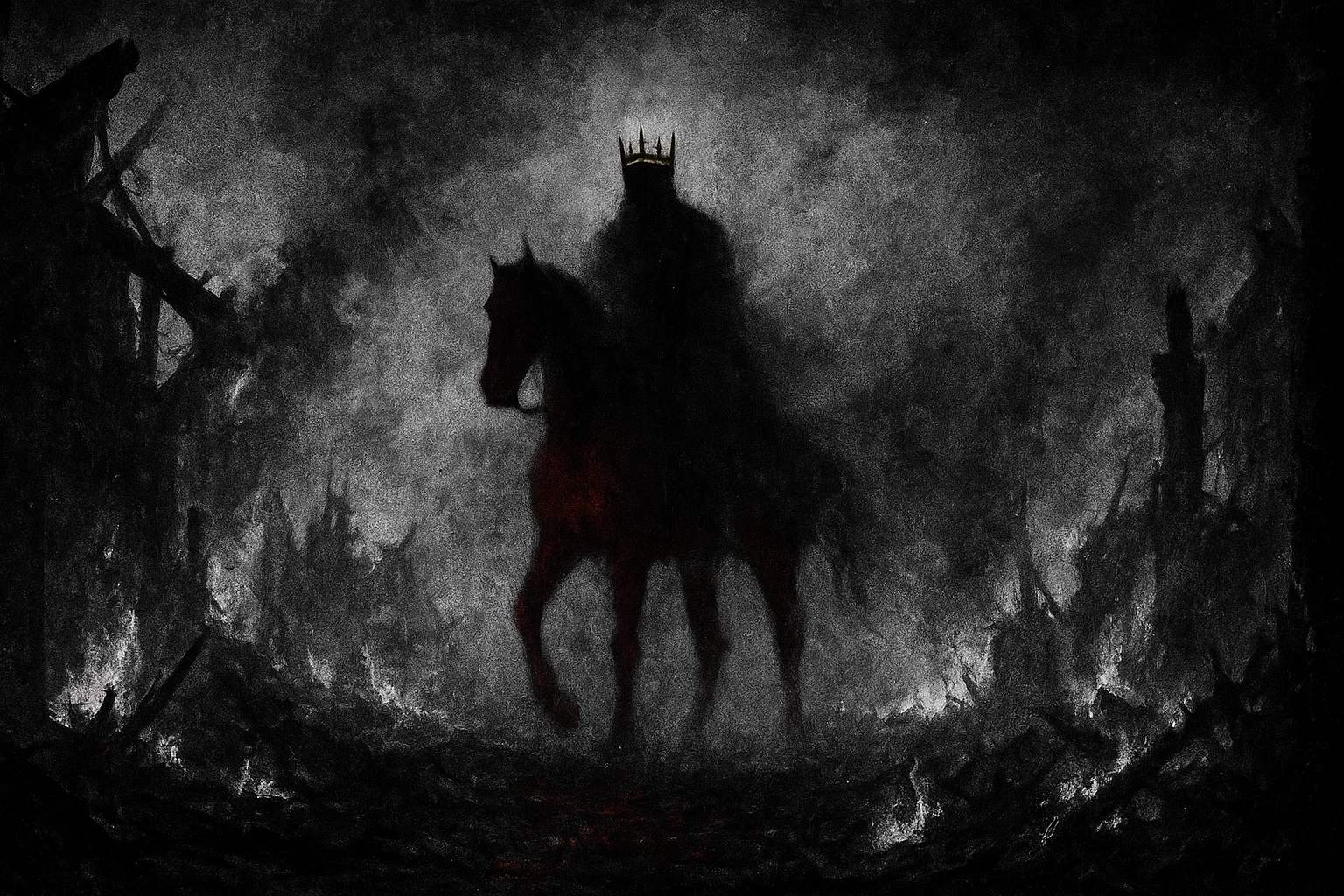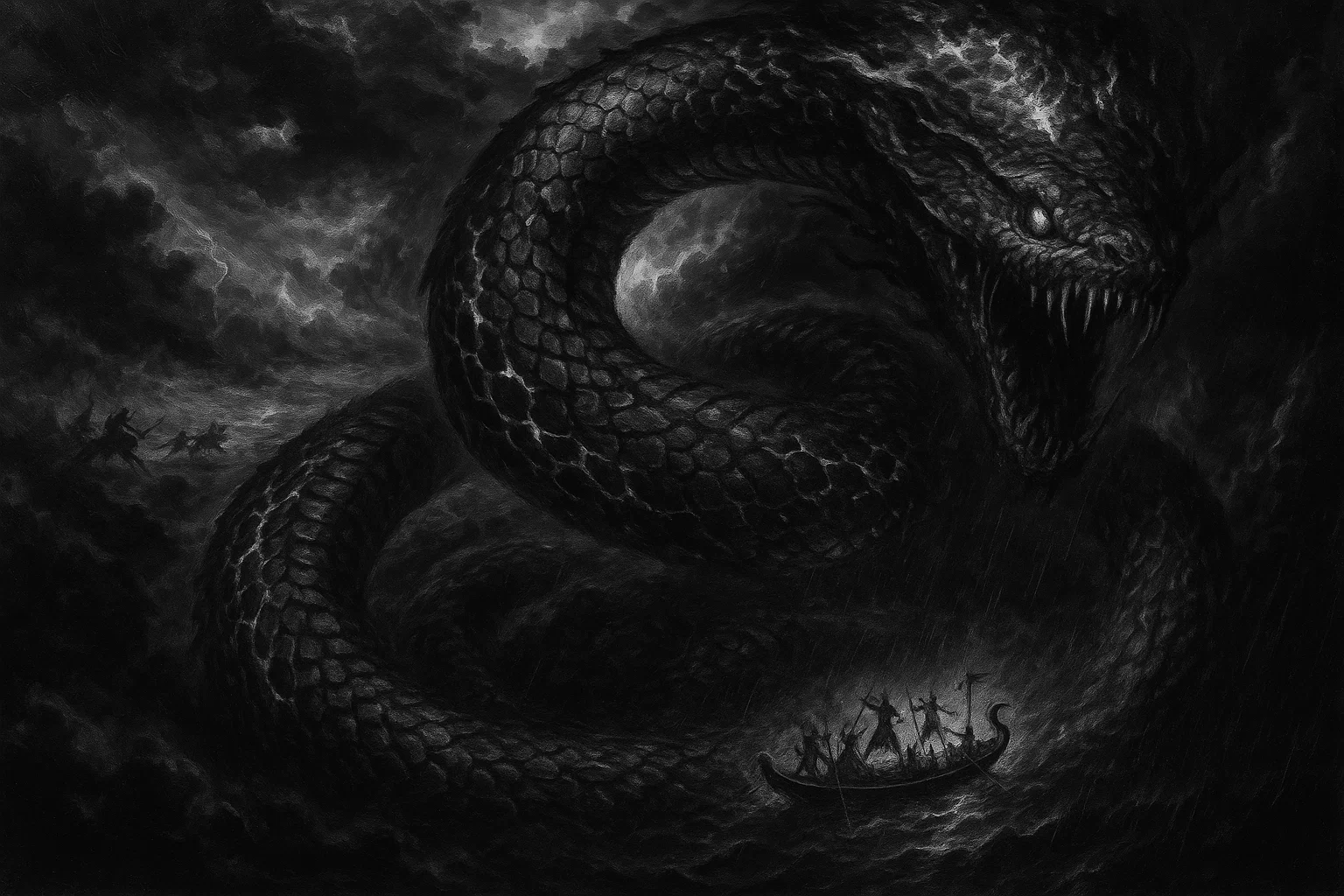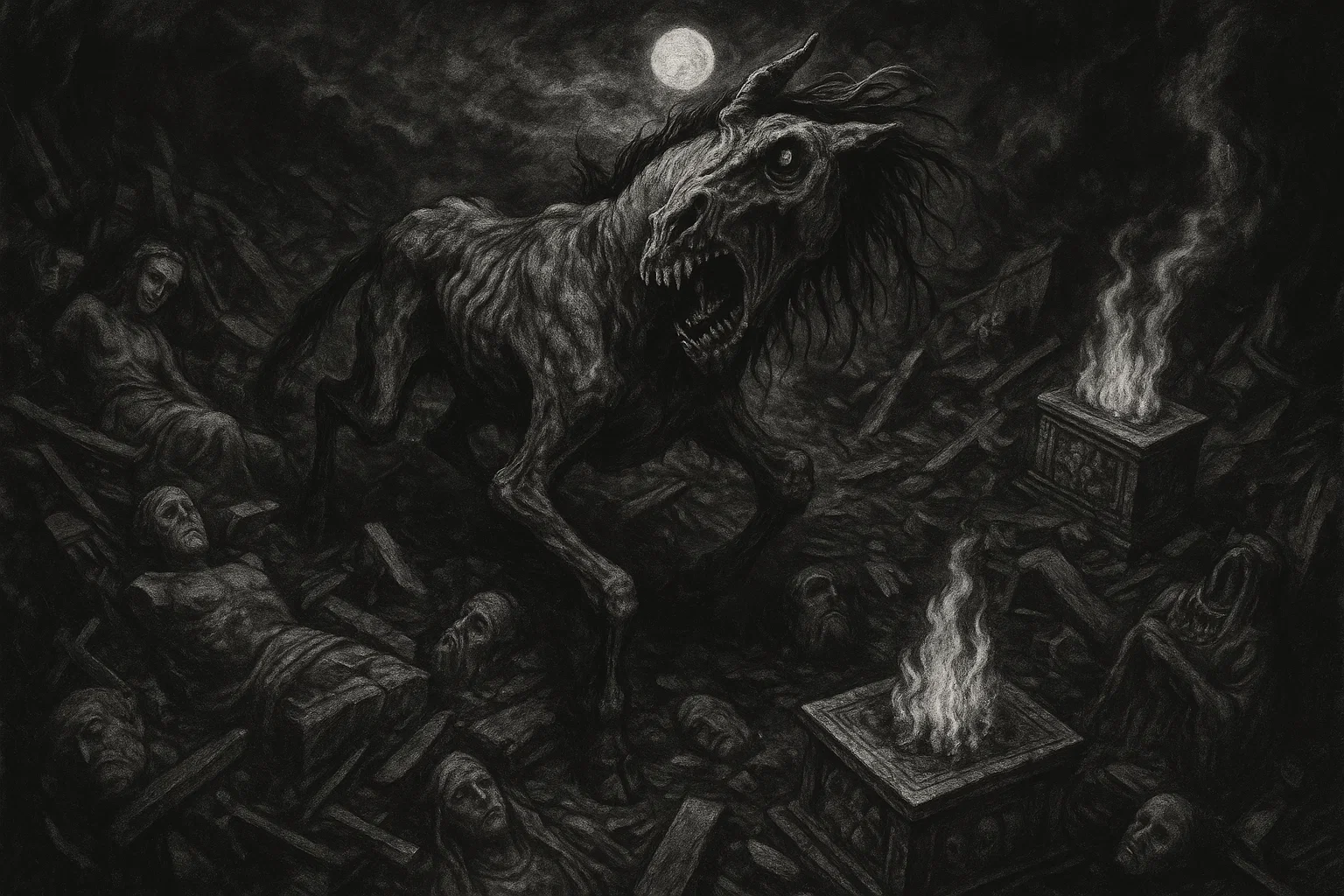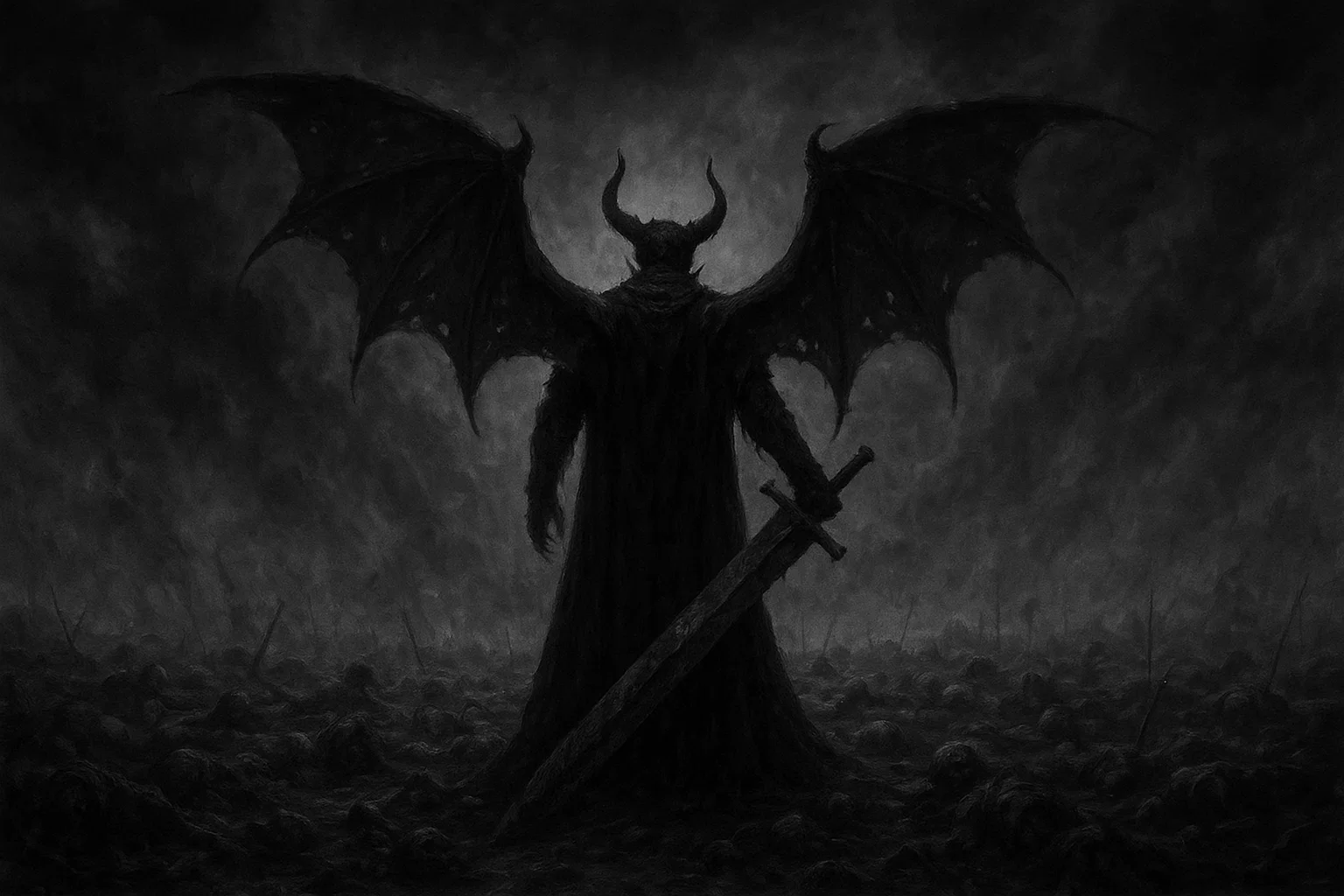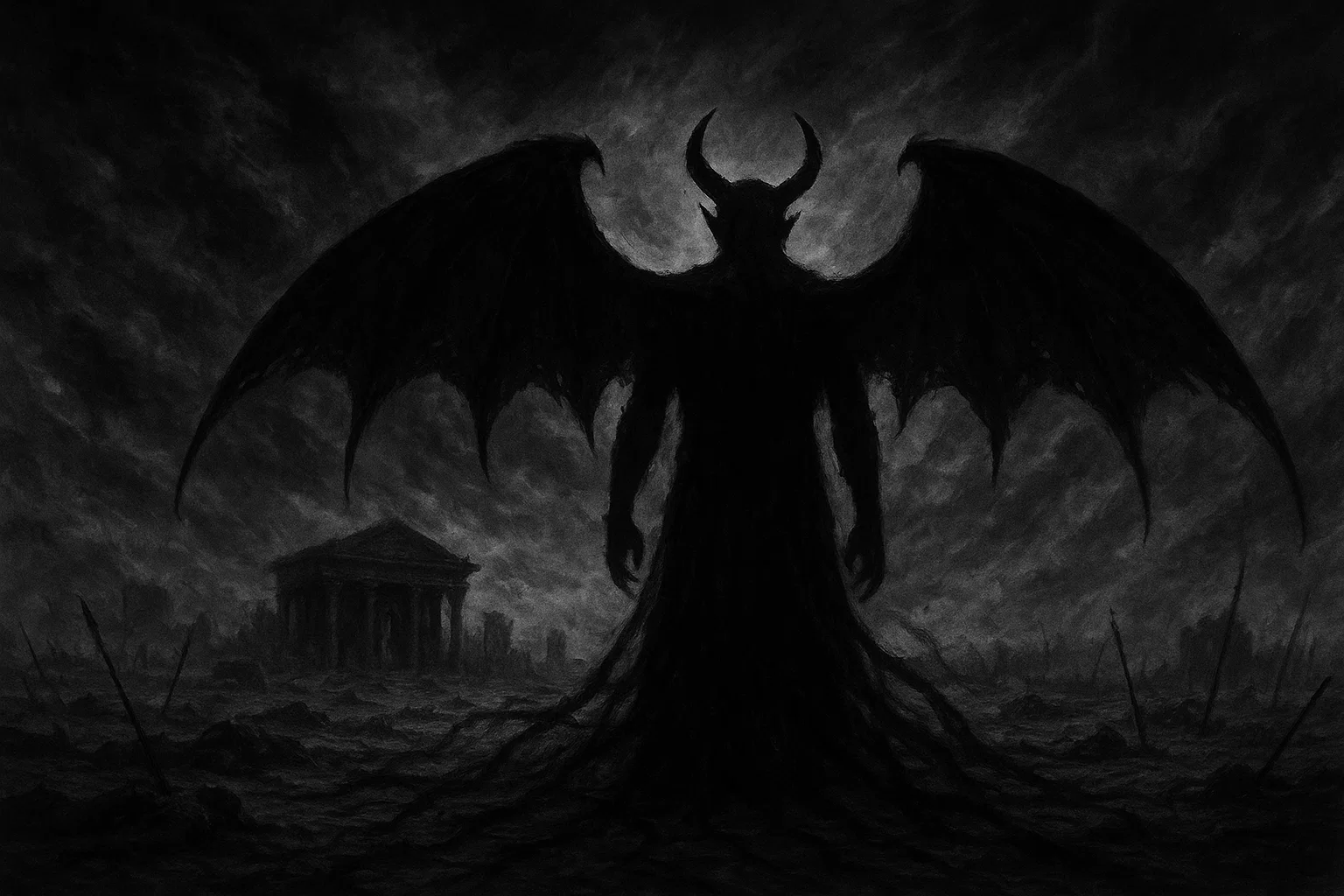In the shadowed annals of ancient demonology, Abezethibou emerges as a chilling embodiment of defiance and malice, a fallen angel whose singular crimson wing marks him as a perpetual outcast from divine grace.
This one-winged demon, steeped in tales of celestial betrayal and earthly corruption, haunts the fringes of biblical lore and occult traditions. What drives a being of such power to harden the hearts of kings and summon tempests from the deep? How does his imprisonment in the watery abyss reflect the eternal struggle between chaos and order?
Abezethibou, often invoked in whispers as the adversary of prophets and the whisperer of prideful rebellion, challenges our understanding of evil’s origins. Could his fall from the heavens foreshadow the temptations that plague humanity today? As we unravel his myth, questions arise: What secrets lie buried in his etymological roots, and how do his powers continue to echo in modern interpretations? Abezethibou beckons us into a world where angels become demons, and defiance becomes damnation.
Table of Contents
Key Information
| Attribute | Details |
|---|---|
| Name | Abezethibou, Abezithibod, Abezethibod, Abezi-Thibod, Abeziberu, Abez, Abezi, Abezithibou, Abyzou (possible variant or related entity) |
| Title | Prince of Hell, Son of Beelzebub, Demon of the Red Sea, Warden of Tartarus, Spirit of Hardened Hearts, Demon of Pride, The True Fallen Angel, Angel of Magic and Miracles (formerly), Adversary of Moses, Hardener of Pharaoh’s Will, One-Winged Scourge, Plotter Against Heavens, Guardian of Imprisoned Souls, Instigator of Rebellion |
| Gender | Male |
| Role | Adversary in biblical confrontations, tempter of rulers and magicians, strategist in infernal legions, guardian of damned souls in Tartarus, corrupter of minds and hearts, provider of deceptive miracles, manipulator of winds and seas, eternal prisoner aiding infernal plots from afar |
| Hierarchy | Prince under the Seven Kings of Hell, direct offspring and chief advisor to Beelzebub, ruler over Tartarus and its tormented inhabitants, commander of lesser demonic forces in aquatic and abyssal realms |
| Servitors | Twelve lesser demons (including insectoid swarms, wind spirits, and heart-corrupting imps; named in esoteric texts as variants like shadow lurkers and pride whisperers) |
| Superior Demon | Beelzebub (father and supreme overlord), Lucifer (ultimate ruler of Hell) |
| Powers | Hardening hearts to foster obstinacy and rebellion, performing illusory signs and wonders to deceive, controlling fierce winds especially over seas to unleash storms, devouring ethereal essences to amplify strength, corrupting angelic and human minds toward malice, lending forbidden magical abilities to mortals, inciting prideful defiance against divine will, manipulating shadows for concealment |
| Appearance | One-winged humanoid with a bloody red wing charred from his fall, muscular angelic frame twisted with monstrous scars and asymmetries, dark charred skin evoking eternal punishment, fierce eyes glowing with vengeful fire, sometimes emerging from watery depths with dripping appendages |
| Etymology | Rooted in Hebrew “ab” (father) and “ez” (devoid), combined with “thibou” implying counsel or wisdom in a twisted, rebellious form; possibly linked to Abyzou or Aramaic terms for abandonment and ethereal voids, symbolizing a fatherless plotter against heavenly order |
| Associated Figures | Beelzebub (father), Naamah (mother in some occult variants), Moses (primary adversary), Pharaoh (influenced victim of heart-hardening), Solomon (summoner and binder), Ephippas (fellow imprisoned demon and liberator), Uriel (heavenly combatant who severed his wing), Azrael (drowner in the Red Sea), Jannes and Jambres (Egyptian magicians who invoked him), Dumah (corrupted angelic ally), Asmodeus (rival in temptation domains), Leviathan (aquatic demonic counterpart) |
| Weaknesses | Susceptibility to divine bindings like Solomon’s ring, entrapment in pillars of water or sea depths, defeat by archangels such as Uriel’s sword or Azrael’s deathly grasp, inability to fully regenerate his lost wing, vulnerability to rituals invoking humility and faith, countered by opposing forces like Raphael’s healing or Michael’s protective might |
| Opposing Angel/Saint | Uriel (severed his wing in battle), Azrael (imprisoned him in the sea), Raphael (counters deceptive miracles), Archangel Michael (overseer of all fallen angels and demons), Gabriel (messenger who exposes lies) |
| Equipment/Tools | Innate ethereal-devouring maw, wind-whipping abilities, deceptive magical signs for wonders, no prominent artifacts but associated with scrying mirrors for illusions and chains for binding souls |
| Pantheon | Jewish demonology, Christian pseudepigrapha, occult grimoires, Abrahamic infernal hierarchy, influences in global fallen angel myths, connections to ancient Near Eastern sea spirits and rebellious entities |
Etymology
The name Abezethibou harbors layers of linguistic malice, drawing from ancient Hebrew, Greek, and Aramaic roots that encapsulate his essence as a rebellious, counsel-deprived entity.
At its core, “Abez” likely derives from “ab” meaning father, fused with “ez” signifying devoid or without, portraying him as a being inherently lacking paternal guidance or divine wisdom. This interpretation aligns with his origin as a fallen angel, born from ambition rather than benevolence, forever marked by isolation.
Further dissection reveals “thibou” as a corruption of terms related to counsel or plotting, possibly echoing Greek influences in pseudepigraphal texts where Abezethibou is rendered as a fatherless schemer.
Some scholars link it to Abyzou, a related spirit in Jewish folklore known for infanticide and misfortune, suggesting a shared etymological thread of abyssal voids and abandonment. In Aramaic echoes, “abez” connotes forsaken realms, while “ibou” hints at ethereal emptiness, reinforcing Abezethibou‘s role as a void-filling tempter who exploits human weaknesses.
Occult linguists propose additional facets, such as ties to Semitic words for rebellion and wing-clipped flight, symbolizing his mutilated form. Variations like Abezithibod or Abezi-Thibod appear in grimoires, potentially blending with Babylonian terms for demonic advisors, emphasizing his advisory yet treacherous nature under Beelzebub.
This multifaceted etymology not only defines Abezethibou but integrates LSI terms like demon nomenclature, fallen angel aliases, biblical adversarial titles, infernal etymological roots, and occult linguistic derivations, enriching his profile in demonological studies. Such depth underscores how names in ancient lore serve as curses, binding entities to their sins.
In broader cultural linguistics, Abezethibou‘s name may parallel Near Eastern demons associated with sea chaos, where “abyss” roots evoke watery prisons. This connection amplifies his identity as the demon of the Red Sea, a linguistic prison mirroring his mythical fate.
You May Also Like: Abalam: Demon of Sorrow and Knowledge
What Does the Demon Abezethibou Look Like?
Abezethibou presents a horrifying visage, his form a grotesque fusion of angelic splendor and infernal punishment. Dominated by a single, bloody red wing—charred, veined, and perpetually dripping symbolic ichor—he embodies eternal incompleteness, his asymmetry a stark reminder of heavenly defeat.
His body, once perfectly sculpted in celestial likeness, now bears twisted scars, blackened skin, and elongated limbs that writhe unnaturally.
In apparitions, Abezethibou towers imposingly, his fierce eyes ablaze with crimson fire, piercing souls with vengeful intent. Monstrous mutations distort his features: jagged fangs for devouring essences, clawed hands for grasping winds, and a shadowy aura that conceals his approach. Emerging from abyssal waters, his wing trails seaweed and brine, evoking both aquatic terror and fallen grandeur.
Historical and Mythological Background
Abezethibou‘s origins trace to the primordial chaos of angelic rebellion, positioning him as a key figure in Jewish demonology and pseudepigraphal narratives. As a fallen angel, he descended from the first heaven, Amelouth, where he allied with Beelzebub in a cataclysmic uprising against divine authority.
His fall, marked by the loss of one wing, symbolizes the irrevocable cost of pride, transforming him into a one-winged demon eternally scheming from the shadows.
Connections to global deities abound, with parallels to sea-bound entities like Leviathan in Hebrew lore or Tiamat in Babylonian mythology, both representing chaotic waters and rebellion.
In Egyptian contexts, Abezethibou echoes Set, the god of disorder who opposed order-bringers like Osiris, mirroring his antagonism toward Moses. Worldwide, he resonates with fallen figures such as Aztec Xolotl, a guide to the underworld with canine traits, or Norse Loki, a trickster instigating cosmic strife. These links suggest a universal archetype of defiant spirits punished by imprisonment or mutilation.
The War in Heaven and Fall from Amelouth
In the celestial upheaval known as the War in Heaven, Abezethibou served as Beelzebub’s fierce lieutenant, devouring the essences of slain angels to bolster his might. Residing in Amelouth, the first heaven, he plotted against every spirit under the skies.
Uriel, the archangel of fire, engaged him in brutal combat, severing one wing and casting him down. This disfigurement fueled his eternal hatred, turning him into a symbol of incomplete rebellion.
Post-fall, Abezethibou wandered earthly realms, his single wing hindering flight but not malice. Legends tie this event to broader fallen angel myths, akin to Islamic Iblis’s refusal to bow, emphasizing pride’s downfall.
You May Also Like: Sallos: The Mysterious Demon of Love
Hardening Pharaoh’s Heart and the Exodus Adversity
Central to Abezethibou‘s infamy is his role in the Exodus, where he hardened Pharaoh’s heart, inciting defiance against Moses’ pleas. Invoked by magicians Jannes and Jambres, he lent deceptive miracles to counter divine plagues, mimicking staffs into serpents and waters into blood.
As Israelites fled, Abezethibou spurred the Egyptian pursuit, only to be engulfed by the closing Red Sea.
Trapped beneath a watery pillar, his imprisonment became a metaphor for subdued evil, with prophecies foretelling release by Ephippas. This narrative intertwines with biblical themes, portraying Abezethibou as the hidden architect of tyranny.
Corruption of Dumah and Clash with Azrael
Venturing into Egyptian shadows, Abezethibou corrupted Dumah, the angel of silence and death, twisting him to amplify plagues upon innocents. This alliance escalated chaos until Azrael, angel of death, intervened, executing the firstborn plague and drowning Abezethibou in the sea. Their clash highlights his manipulative genius and susceptibility to righteous retribution.
Parallels exist with Persian Angra Mainyu, a corrupter of good spirits, underscoring Abezethibou‘s cross-cultural motif of perverting allies.
Summoning by Solomon and Eternal Binding
King Solomon, armed with his divine ring, summoned Abezethibou through Ephippas, forcing confessions of heavenly plots and Exodus meddling.
Bound alongside Ephippas to support a temple pillar, his labor endures as punishment, symbolizing human dominion over demons. This tale from the Testament of Solomon cements his subjugation, echoing global myths like Greek Prometheus’s chaining for defiance.
Role in Infernal Incursions and Battles with Heroes
In later infernal lore, Abezethibou aided Beelzebub’s earthly invasions, commanding legions to sow discord. One variant depicts him battling legendary heroes like Sparda, unleashing poisons, speeds, and insect swarms—yet overpowered by superior will. Modern interpretations link him to video game antagonists, inspiring one-winged villains in pop culture.
Connections to Worldwide Deities and Demons
Abezethibou‘s myth resonates globally: in Hindu lore, he parallels Asuras like Vritra, sea-imprisoned rebels; in Celtic tales, to Fomorians, aquatic chaos-bringers; and in African Yoruba traditions, to Eshu, a trickster of crossroads and deception. These ties suggest ancient migrations of demonic archetypes, from Near Eastern origins to worldwide adaptations, portraying him as a universal symbol of aquatic malice and fallen pride.
You May Also Like: Who Is the Demon Gremory in Ars Goetia?
Historical Mentions
| Text/Grimoire | Year | Description | Excerpt |
|---|---|---|---|
| Testament of Solomon | 100-400 AD | Abezethibou is a one-winged demon, descendant of an archangel, who hardened Pharaoh’s heart, opposed Moses, and was trapped in the Red Sea until summoned by Solomon. | “I, O King Solomon, am called Abezithibod. I am a descendant of the archangel. Once as I sat in the first heaven, of which the name is Ameleouth — I then am a fierce spirit and winged, and with a single wing, plotting against every spirit under heaven. I was present when Moses went in before Pharaoh, king of Egypt, and I hardened his heart. I am he whom Iannes and Iambres invoked homing with Moses in Egypt. I am he who fought against Moses with wonders with signs… In the exodus of the sons of Israel I hardened the heart of Pharaoh. And I excited his heart and that of his ministers. And I caused them to pursue after the children of Israel. And Pharaoh followed with (me) and all the Egyptians. Then I was present there, and we followed together. And we all came up upon the Red Sea. And it came to pass when the children of Israel had crossed over, the water returned and hid all the host of the Egyptians and all their might. And I remained in the sea, being kept under this pillar.” |
Abezethibou’s Powers and Abilities
Abezethibou possesses specialized abilities that set him apart from commonplace demonic forces, focusing on psychological manipulation and elemental chaos rather than brute possession.
His signature power, hardening hearts, subtly erodes resolve, turning leaders like Pharaoh into vessels of obstinacy and pride, leading to self-destructive pursuits. This corruption tempts through inflated ego, whispering promises of invincibility that culminate in ruin.
Distinctively, Abezethibou performs signs and wonders, crafting illusions of divine power to empower mortals, as with Egyptian magicians mimicking plagues. He corrupts by offering arcane knowledge, luring seekers into hubris and moral decay. Wind control over seas unleashes devastating storms, tempting navigators with false safety before drowning them in turmoil.
His essence-devouring trait, rare among demons, absorbs angelic or human life forces, amplifying his vigor while corrupting victims through drained vitality. In pop culture adaptations, such as fan-inspired characters in games like Fate series or Genshin Impact’s Arlecchino, Abezethibou gains modern powers like shadow manipulation for stealthy assaults or one-winged flight bursts for rapid strikes, reflecting interpretations of his rebellious speed and poison-infused attacks.
Mind corruption twists allies toward evil, as with Dumah, fostering betrayal and isolation. Newer lore adds pride inducement, inciting societal rebellions, and abyssal summoning, drawing watery horrors to aid him.
You May Also Like: Complete Guide to Wyoming Bigfoot Sightings (1967–2025)
Powers and Abilities Breakdown
| Power/Ability | Description | Source | How It Tempts/Corrupts Humans | Countermeasure |
|---|---|---|---|---|
| Hardening Hearts | Instills unyielding stubbornness, resisting divine or moral calls. | Testament of Solomon, Jewish demonology | Fuels pride, leading to tyrannical decisions and downfall, like Pharaoh’s chase. | Archangel Michael’s protective invocations; humility-focused prayers. |
| Performing Signs and Wonders | Generates deceptive miracles, empowering others with false magic. | Pseudepigraphal texts, occult lore | Lures with godlike power, corrupting into arrogance and forbidden pacts. | Solomon’s binding ring; Raphael’s illuminating truth. |
| Controlling Winds Over Seas | Summons gales and storms, especially aquatic tempests. | Expanded myths, sea demon associations | Exploits fear of nature, driving desperate alliances with darkness. | Azrael’s drowning rituals; earth-anchoring spells. |
| Devouring Aether/Essences | Consumes life forces to enhance strength, leaving victims weakened. | Heavenly war narratives | Promises eternal vigor, corrupting via soul erosion and dependency. | Uriel’s fiery purification; essence-shielding amulets. |
| Corrupting Minds | Warps thoughts toward malice, turning allies against good. | Corruption of Dumah tales | Breeds distrust and betrayal, isolating individuals in moral voids. | Exorcisms invoking Gabriel; saintly intercessions like St. Michael’s sword. |
| Inciting Prideful Defiance | Amplifies ego to rebel against authority, societal or divine. | Modern interpretations, pop culture | Tempts with superiority illusions, leading to chaotic uprisings. | Faith rituals; opposing humility from saints. |
| Shadow Manipulation | Conceals in darkness or summons shadowy tendrils for attacks. | Fanon expansions, game lore | Corrupts through hidden sins, encouraging secretive evil deeds. | Light-based banishments; Uriel’s illumination. |
| Abyssal Summoning | Calls forth watery horrors or lesser sea demons. | Global mythological parallels | Lures with command over monsters, corrupting via destructive alliances. | Water-sealing bindings; Azrael’s interventions. |
How to Counter Abezethibou’s Powers
Defending against Abezethibou requires layered strategies blending faith, ritual, and angelic aid, targeting his manipulative and elemental strengths. For heart-hardening, cultivate humility through daily invocations of Archangel Michael, using protective talismans etched with divine names to fortify mental barriers. Rituals with holy oils anoint the afflicted, dissolving pride’s grip.
Illusory signs yield to truth-revealing mirrors or Solomon-inspired circles, where chanting exposes deceptions. Raphael’s healing light dispels false wonders, grounding practitioners in reality.
Wind storms counter via elemental equilibrium: anchor with earth symbols or invoke opposing air entities to calm gales. Sea-based threats demand water-binding spells, mimicking his Red Sea prison.
Essence-devouring halts with Uriel’s fiery wards, purifying absorbed energies through flame meditations. Mind corruption necessitates exorcisms, calling Gabriel to unveil lies and restore clarity.
Overall, Abezethibou‘s temptations crumble under unified faith and knowledge; pride is his entry, so humility seals the door. Advanced countermeasures include abyssal seals, preventing summons, and prophetic visions to anticipate his schemes.
You May Also Like: The Cursed Noh Mask | Horror Story
Abezethibou’s Role in the Hierarchy of Hell
Within Hell’s chaotic hierarchy, Abezethibou holds a princely station as Beelzebub’s direct heir and advisor, commanding respect among the Seven Kings.
He rules Tartarus, the abyssal prison for wicked souls and ancient Titans, overseeing torments with unyielding cruelty. His domain extends to watery depths, mirroring his Red Sea entrapment, where he governs drowned spirits and sea-bound demons.
Armies under his command include twelve servitor legions: insectoid swarms for plagues, wind imps for storms, and heart-corrupting shades for subversion. Notable subordinates encompass shadow lurkers and pride whisperers, executing his bids from afar.
Superiors like Beelzebub dictate strategies, with Lucifer as ultimate sovereign. Allies include Asmodeus for shared temptation arts and Leviathan for aquatic synergies, forming pacts against heavenly forces.
Adversaries abound: Belial rivals his deceptive gifts, while Astaroth contests knowledge domains. His resentment toward Beelzebub for abandonment fuels internal tensions, yet loyalty binds him. Comparable ranks feature Agares as ministers, but Abezethibou‘s lineage elevates him, burdening eternal vigilance in Hell’s underbelly.
Astrological Associations and Symbolism
Abezethibou aligns with Mars for aggressive rebellion, his fiery essence fueling conflict and defiance. Water and air elements dominate, tying to his sea prison and wind powers, symbolizing fluid deception and stormy chaos. Numbers like one evoke solitude, twelve his servitors, signifying incomplete cycles.
Tuesdays harness Martian energy for invocations, though his nocturnal preference favors moonlit rites. Metals include iron for unyielding strength, copper for conductive malice. Crystals such as bloodstone enhance vitality, ruby amplifies rage, obsidian shields shadows.
Colors: red for his wing and bloodied fall, black for abyssal depths, salmon blue for watery domains. Zodiacally, Scorpio mirrors transformative venom, Aquarius erratic winds. Symbolism extends to pride’s sin, with chains representing bindings, seas eternal punishment.
Planetary ties include Saturn for imprisonment, Neptune for illusory depths. Precious stones like garnet symbolize hardened hearts, sapphire deceptive wonders.
| Association | Details |
|---|---|
| Planet | Mars (aggression), Saturn (punishment), Neptune (illusions) |
| Element | Water (abyssal prison), Air (winds), Fire (rebellious fall) |
| Number | 1 (isolation), 12 (legions), 7 (infernal kings) |
| Day | Tuesday (Martian), nights under Scorpio moons |
| Metal | Iron (strength), Copper (conductivity), Lead (heaviness) |
| Stone/Crystal | Bloodstone (vitality), Ruby (rage), Obsidian (shadows), Garnet (hardness), Sapphire (deception) |
| Color | Red (wing), Black (charred skin), Salmon Blue (sea), Crimson (blood) |
| Zodiac | Scorpio (transformation), Aquarius (unpredictability), Capricorn (ambition) |
You May Also Like: Was the Infamous Vseslav of Polotsk a Werewolf?
Abezethibou’s Sigil
Though not canonically detailed in major grimoires, Abezethibou‘s sigil manifests in occult circles as an asymmetrical glyph, incorporating a jagged wing motif and swirling abyssal lines to invoke his mutilated form.
Etched during Martian hours, it channels nocturnal malice for confusion spells or divination, demanding iron tools for potency. Misuse risks backlash, echoing his rebellious nature.
Rituals expand to symbolic offerings, enhancing summons or protections.
| Symbol/Item | Association/Meaning | Use in Rituals |
|---|---|---|
| Animal | Fly (Beelzebub lineage), Scorpion (venomous strike), Jackal (deathly prowl) | Sacrificial offerings for pacts; wards against betrayal |
| Plant | Nightshade (poisonous deception), Seaweed (abyssal ties) | Incense for shadowy invocations; potions for mind twists |
| Incense | Sandalwood (ethereal voids), Myrrh (mourning fall) | Enhances manifestation; dispels illusions in banishments |
| Wing Feather | Symbol of mutilated flight and rebellion | Focal amulet in bindings; empowers defiant spells |
| Red Candle | Bloodied wing and rage | Illumination for summons; represents vengeful fire |
| Scrying Mirror | Divinatory deception | Communicates temptations; reverses for exposures |
| Iron Chain | Martian binding and punishment | Restrains influences; chains in exorcisms |
| Water Vial | Red Sea prison and watery chaos | Traps essences; used in drowning rituals |
| Bloodstone | Vitality from devoured forces | Amplifies strength; counters essence loss |
| Obsidian Blade | Shadow cutting and malice | Slices through deceptions; ritual sacrifices |
Comparison with Other Demons
| Demon | Role | Powers | Appearance | Hierarchy |
|---|---|---|---|---|
| Beelzebub | Lord of Flies, chief tempter | Legion command, gluttony inducement, disease spreading | Fly-hybrid, multi-formed monstrosity | King of Hell, direct superior and father to Abezethibou |
| Asmodeus | Destroyer of unions, wrath inciter | Marriage disruption, lustful vengeance, shape-shifting | Three-headed beast with serpent tail | King, rival in corruption and temptation spheres |
| Belial | Promoter of lawlessness, deceiver | Gift-bestowing, false alliances, earth manipulation | Chariot-riding fallen angel | Prince, parallel advisory and subversive roles |
| Astaroth | Revealer of secrets, scholar | Past/future visions, herbal knowledge, invisibility | Foul-smelling angel on dragon | Duke, lower rank but overlapping in arcane lending |
| Leviathan | Envy’s serpent, sea chaos | Doubt sowing, oceanic disasters, envy amplification | Colossal sea dragon with multiple heads | Prince, shared aquatic domains and chaotic influences |
| Mammon | Greed’s idol, wealth tempter | Material riches, avarice corruption | Golden-hoarding figure | Prince, contrasting material vs. psychological temptations |
| Lucifer | Pride’s light-bringer, rebel leader | Illumination deception, pride inflation | Radiant yet shadowed fallen seraph | Supreme ruler, outranks all with overarching command |
| Azazel | Scapegoat teacher, forger | Weaponry instruction, cosmetics allure | Goat-human hybrid with chains | Watcher fallen angel, kinship in teaching forbidden arts |
| Samael | Venom of God, accuser | Poisoning, death’s angel, accusation | Serpent-winged reaper | Archangel turned demon, similar in adversarial roles |
| Lilith | Night hag, seductress | Child-strangling, independence rebellion | Winged woman-serpent | Queen, allied in defiance but rival in gender dynamics |
You May Also Like: Mackenzie Poltergeist: World’s Most Violent Haunting?
Conclusion
Abezethibou‘s enduring myth warns of rebellion’s bitter fruits, his one-winged form a perpetual scar of celestial hubris. From hardening ancient tyrants to whispering modern temptations, he embodies evil’s insidious creep, challenging us to confront inner defiance.
Yet, his imprisonment offers hope: even potent demons yield to divine order. As lore evolves, Abezethibou reminds that unchecked pride invites ruin, urging vigilance against shadowy influences.
In demonology’s vast tapestry, Abezethibou weaves a thread of caution, blending ancient fears with timeless truths. His story, rich in symbolism and strife, endures as a mirror to humanity’s darker impulses.


